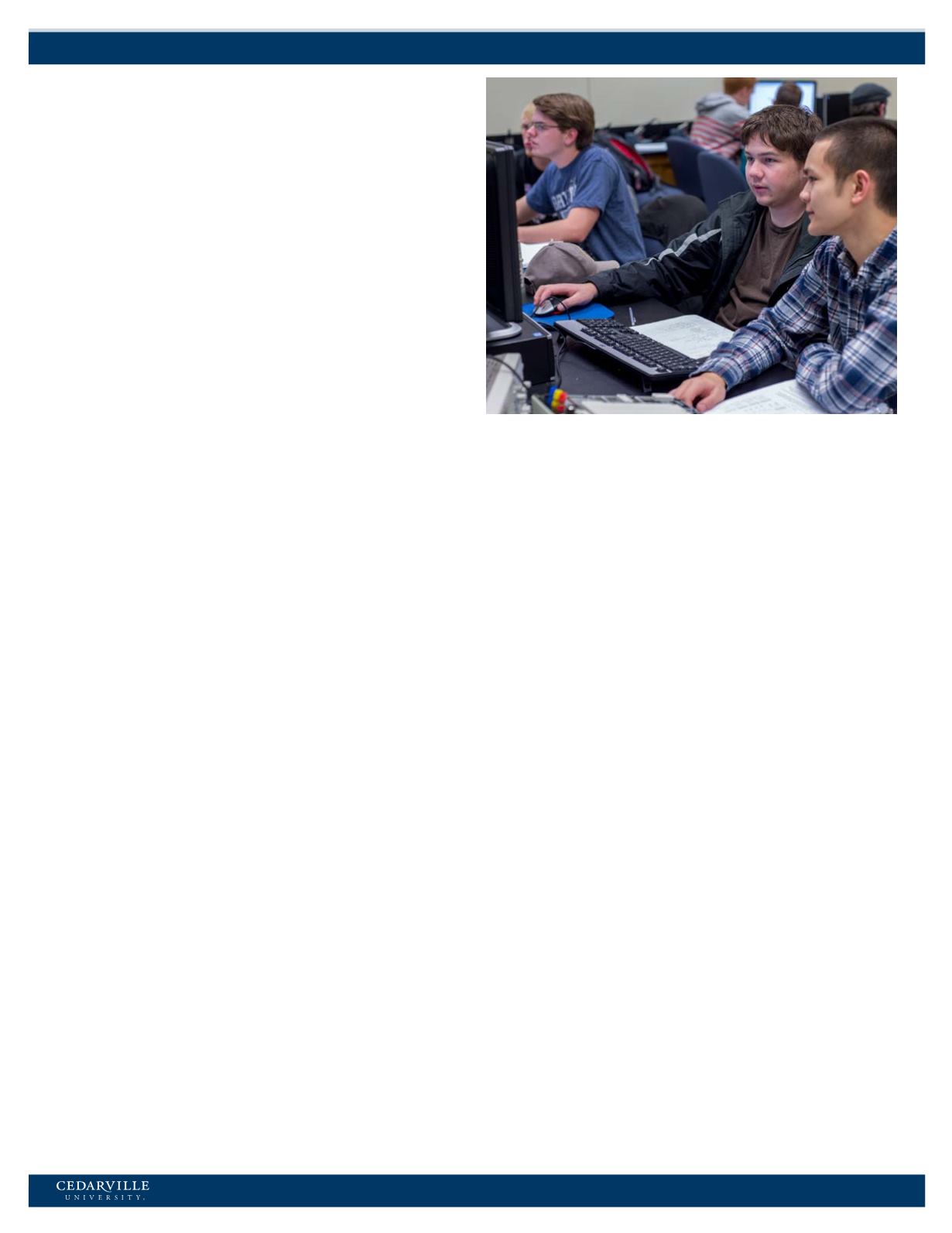

Technical Resources
Our modern laboratories include the following: fluids lab with
an 18-inch cross-section wind tunnel, heat transfer, refrigeration,
mechanics, materials testing, internal combustion engines,
and dynamometers, CNC manufacturing, vibrations, dynamics
of machines, electrical machines, feedback controls, circuits,
electronics, communications, digital logic design, microprocessors,
and surface-mount soldering. We also have extensive PC-based
laboratories in which students use computer-based circuit design,
3-D solid modeling, FEA, CFD, CNC, and industry-standard IDE
software.
Cocurricular Opportunities
Engineering freshmen participate in an annual Cardboard
Canoe Challenge. Other course-based competitions include
statics and dynamics design competitions for sophomores, an
Advanced Digital Logic Design competition, and an annual
programming contest. The department provides students with
opportunities to participate in national and international design
competitions organized by professional engineering societies
such as ACM, ASME, IEEE, SAE, ASEE, and SWE. Our students
participate in Aero Design
®
, Formula SAE
®
, international
programming, robotics, Solar Splash
®
, and Supermileage
®
competitions.
Career Opportunities
Engineering and computer science both involve the application
of scientific and mathematical principles, experience, judgment,
and common sense to develop devices which help people.
Engineers redesign products to work more efficiently, more
quickly, and less expensively. They design EKG and ultrasound
machines that help doctors diagnose medical problems, electrical
engineering plants to power our cities, and more fuel-efficient
cars and airplanes. Computer programmers develop the software
solutions that are used to pilot spacecraft, combat terrorism,
prevent collisions at airports, and keep our cars running.
Computer scientists and engineers spend a great deal of
time interacting and communicating with others, often working
on a team. Because of their strong background in science,
mathematics, and technology, they often rise to leadership
positions in organizations, managing programs in research,
development, design, construction, production, operations,
marketing, and sales.
In this era of rapid technological change, an engineering
or computer science education serves our society well. In the
decades ahead, society’s needs and problems will call for
technical contributions on a scale not previously experienced.
Engineering Educational Objectives
The School of Engineering and Computer Science educational
objectives define God-honoring characteristics of our students
three to five years after graduation from Cedarville University.
1. They are successful in professions related to their fields of
study.
2. They are successful in graduate-level education.
3. They continue to develop professionally and remain current
in their fields.
4. They make sound professional and ethical decisions based
upon biblical truths.
5. They continue to grow in service and support of Christian
ministries, both in their communities and around the world.
Educational Philosophy for Engineering
and Computer Science Programs
All of our programs are designed to give our graduates a solid
background in their technical fields of choice. Our programs
include a strong theoretical foundation as well as significant
hands-on application. Each program also includes a senior
capstone design experience. The three engineering programs
share a common philosophy of program outcomes which are
consistent with the ABET engineering criteria. Similarly, our
computer science program philosophy is consistent with the ABET
computer science criteria.
Faculty
Robert Chasnov
,
Dean
; Senior Professor of Engineering.
Education:
B.S., Rensselaer Polytechnic Institute, 1978; M.S.,
University of Illinois, 1980; Ph.D., University of Illinois, 1983;
registered professional engineer. At Cedarville since 1991.
Samuel SanGregory
,
Assistant Dean;
Professor of Electrical
Engineering.
Education:
B.S.E., Wright State University, 1988;
M.S.C.E., Air Force Institute of Technology, 1992; Ph.D., Air Force
Institute of Technology, 1999. At Cedarville since 1993.
Gerald Brown
, Associate Professor of Electrical Engineering.
Education:
B.Engr., McMaster University, 1982; M.Engr.,
McMaster University, 1984; Ph.D., McMaster University, 1989.
At Cedarville since 2004.
Timothy Dewhurst
, Senior Professor of Mechanical Engineering.
Education:
B.S.M.E., Cornell University, 1980; M.Eng.M., Cornell
University, 1981; Ph.D., Cornell University, 1985; registered
professional engineer. At Cedarville since 1996.
Patrick Dudenhofer
, Assistant Professor of Computer Science.
Education:
B.S., Cedarville University, 2004; M.S. Wright State
University, 2011. At Cedarville since 2014.
Vicky Fang
, Associate Professor of Computer Engineering.
Education:
B.S.E.E., Shaghai Jiao Tong University, 1992; M.S.E.T.,
Pittsburg State University, 1998; Ph.D., The University of Akron,
2004. At Cedarville since 2004.
David Gallagher
, Professor of Computer Science.
Education:
B.S.E.E., United States Air Force Academy, 1978; M.S.E.E., Air
Force Institute of Technology, 1987; Ph.D., University of Illinois,
1995. At Cedarville since 2000.
Seth Hamman
, Assistant Professor of Computer Science.
Education:
B.A., Duke University, 2002; M.S. Yale University, 2011.
At Cedarville since 2012.
Page
89
2015–16 Undergraduate Academic Catalog
School of Engineering and Computer Science
Technical Resources



















